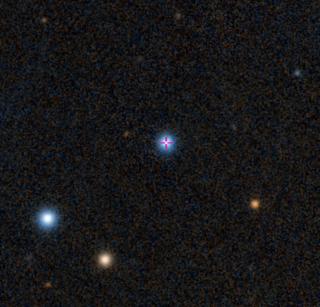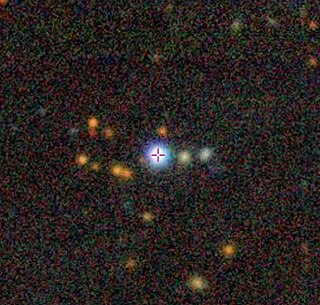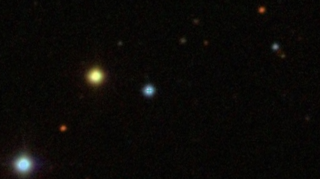Related Research Articles

A quasar is an extremely luminous active galactic nucleus (AGN). It is sometimes known as a quasi-stellar object, abbreviated QSO. The emission from an AGN is powered by a supermassive black hole with a mass ranging from millions to tens of billions of solar masses, surrounded by a gaseous accretion disc. Gas in the disc falling towards the black hole heats up and releases energy in the form of electromagnetic radiation. The radiant energy of quasars is enormous; the most powerful quasars have luminosities thousands of times greater than that of a galaxy such as the Milky Way. Quasars are usually categorized as a subclass of the more general category of AGN. The redshifts of quasars are of cosmological origin.
An active galactic nucleus (AGN) is a compact region at the center of a galaxy that emits a significant amount of energy across the electromagnetic spectrum, with characteristics indicating that this luminosity is not produced by the stars. Such excess, non-stellar emissions have been observed in the radio, microwave, infrared, optical, ultra-violet, X-ray and gamma ray wavebands. A galaxy hosting an AGN is called an active galaxy. The non-stellar radiation from an AGN is theorized to result from the accretion of matter by a supermassive black hole at the center of its host galaxy.

Wolf–Rayet stars, often abbreviated as WR stars, are a rare heterogeneous set of stars with unusual spectra showing prominent broad emission lines of ionised helium and highly ionised nitrogen or carbon. The spectra indicate very high surface enhancement of heavy elements, depletion of hydrogen, and strong stellar winds. The surface temperatures of known Wolf–Rayet stars range from 20,000 K to around 210,000 K, hotter than almost all other kinds of stars. They were previously called W-type stars referring to their spectral classification.

In the fields of Big Bang theory and cosmology, reionization is the process that caused electrically neutral atoms in the universe to reionize after the lapse of the "dark ages".

APM 08279+5255 is a very distant, broad absorption line quasar located in the constellation Lynx. It is magnified and split into multiple images by the gravitational lensing effect of a foreground galaxy through which its light passes. It appears to be a giant elliptical galaxy with a supermassive black hole and associated accretion disk. It possesses large regions of hot dust and molecular gas, as well as regions with starburst activity.

3C 249.1 is a Seyfert galaxy located in the constellation Draco. It hosts a powerful radio source and is located at redshift 0.3115, with a peculiar radio structure. One of its radio lobes is classified as having a Fanaroff-Riley classification Type II, while the other lobe has no features nor containing hotspots.

Hercules A is a bright astronomical radio source in the constellation Hercules corresponding to the galaxy 3C 348.

NGC 3862 is an elliptical galaxy located 300 million light-years away in the constellation Leo. Discovered by astronomer William Herschel on April 27, 1785, NGC 3862 is an outlying member of the Leo Cluster.

III Zw 2 is a Seyfert 1 galaxy located in the Pisces constellation. It has a redshift of 0.089 and is notable as the first of its kind to exhibit a superluminal jet.

4C +71.07 known as S5 0836+71, is a quasar located in the constellation Ursa Major. Based on its high redshift, the object is located 10.7 billion light-years away from Earth and such, classified as a blazar with a flat-spectrum radio source and features a radio jet.

PKS 0537-286, also known as QSO B0537-286, is a quasar located in the constellation Columba. With a redshift of 3.104, the object is located 11.4 billion light years away and belongs to the flat spectrum radio quasar blazar subclass (FSQR). It is one of the most luminous known high-redshift quasars.

PKS 0438-436, also known as PKS J0440-4333, is a quasar located in constellation Caelum. With a high redshift of 2.86, the object is located 11.2 billion light-years from Earth and is classified as a blazar due to its flat-spectrum radio source, (in terms of the flux density as with α < 0.5 and its optical polarization.

PKS 2126-158, also known as PKS 2126-15, is a quasar located in Capricornus. It has a redshift of 3.268000, which corresponds to the distance of 11.5 billion light years. It is classified as a gigahertz peaked-spectrum quasar (GPS) with a flat-spectrum radio source and a blazar, a type of active galaxy shooting an astrophysical jet towards Earth.

SBS 1425+606 also known as HS 1425+6039 and QSO B1425+606, is a quasar located in the constellation Ursa Major. Its redshift is 3.197157, putting the object at a light travel time distance of 11.4 billion light years.

UM 287 known as PHL 868 and LBQS 0049+0045, is a quasar located in the Cetus constellation. Its redshift is 2.267134 estimating the object to be located 10.9 billion light-years away from Earth.

4C +72.26 known as NAME TX J1908+7220, is a radio galaxy located in the constellation Draco. At the redshift of 3.53, the galaxy is located roughly 11.5 billion light-years from Earth.

PKS 1345+125 known as PKS 1345+12 and 4C +12.50, is an ultraluminous infrared galaxy (ULIG) with an active galactic nucleus, located in the constellation Boötes. With a redshift of 0.121740, the galaxy is located 1.7 billion light-years from Earth.

PKS 0736+017 is a blazar located in the constellation of Canis Minor. This object is also a highly polarized compact radio quasar. Its source having a radio spectrum, appears to be flat, making it a flat spectrum radio quasar. It has a redshift of (z) 0.189 and is hosted in a large elliptical galaxy with a half light radius measurement of re = 13 kiloparsecs. The black hole mass in PKS 0736+017 is 7.32+0.89-0.91 x 107 Mʘ based on a full width at half maximum (FWHM) scaling factor and virial relation.
References
- 1 2 3 4 5 "Query : 3C 191". Simbad. Centre de Données astronomiques de Strasbourg . Retrieved 2 June 2015.
- 1 2 3 "NED results for object 3C 191". NASA/IPAC Extragalactic Database. Retrieved 2 June 2015.
- 1 2 Perry, Judith J.; Dyson, J. E. (1990-10-01). "3C 191 Revisited: Circumquasar Shells and Radio Jets". The Astrophysical Journal. 361: 362. Bibcode:1990ApJ...361..362P. doi:10.1086/169202. ISSN 0004-637X.
- ↑ Hamann, Frederick W.; Barlow, T. A.; Chaffee, F. C.; Foltz, C. B.; Weymann, R. J. (2001-05-18). "High Resolution Spectra of Quasar AALs: 3C 191". arXiv: astro-ph/0105337 .
- ↑ Williams, R. E.; Strittmatter, P. A.; Carswell, R. F.; Craine, E. R. (1975-12-01). "Splitting of absorption lines in 3C 191". The Astrophysical Journal. 202: 296–302. Bibcode:1975ApJ...202..296W. doi:10.1086/153976. ISSN 0004-637X.
- ↑ Hamann, Frederick W.; Barlow, T. A.; Chaffee, F. C.; Foltz, C. B.; Weymann, R. J. (2001-03-20). "High-Resolution Keck Spectra of the Associated Absorption Lines in 3C 191". The Astrophysical Journal. 550 (1): 142–152. arXiv: astro-ph/0011030 . Bibcode:2001ApJ...550..142H. doi:10.1086/319733. ISSN 0004-637X.